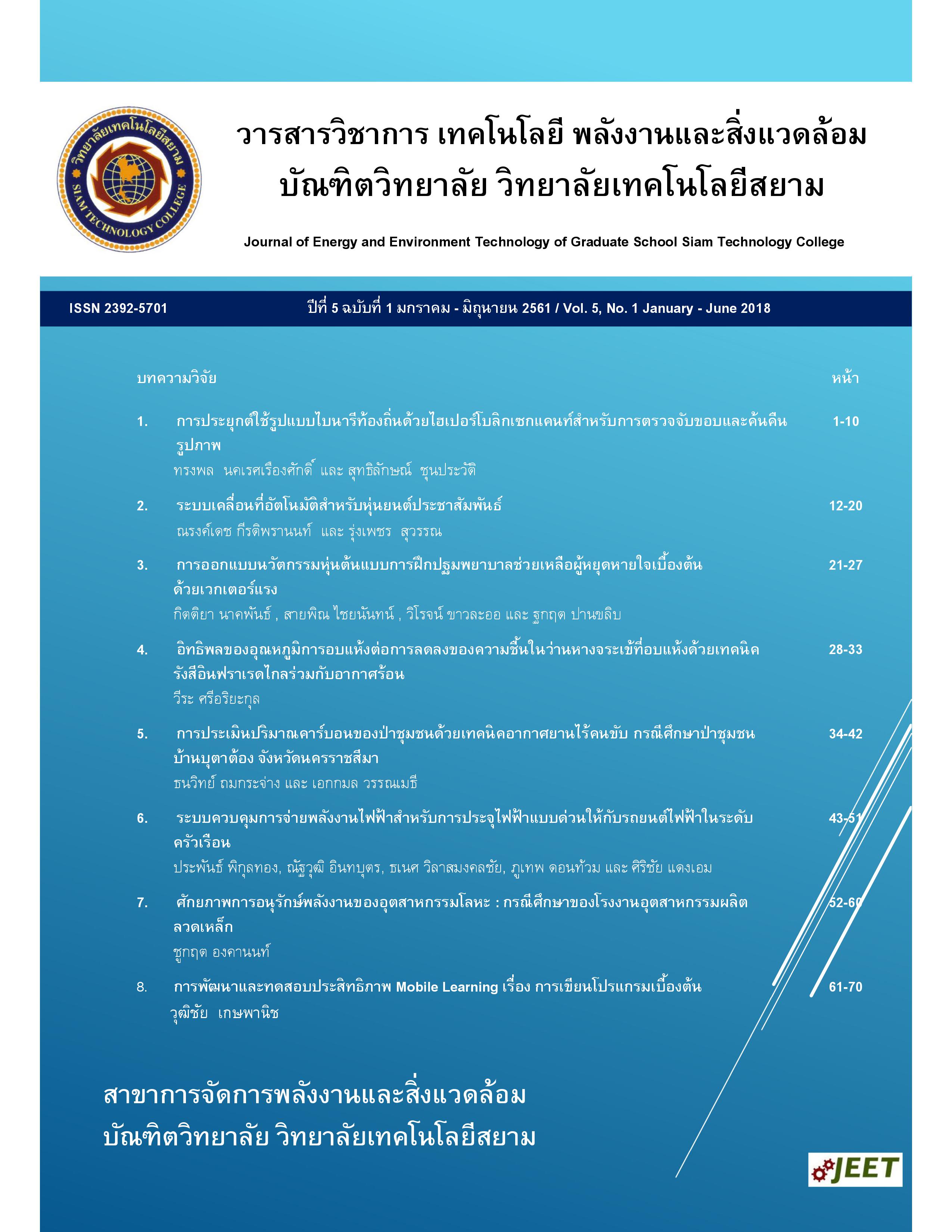Robot Navigation for PR Robot
Main Article Content
Abstract
Recently, robots have been increasing their importance in human lives not only in various industries, but also in home usage. This article presents a design and development of a personal reaction robot, called PJuk. PJuk is designed for interaction with human gesture and voice. The user can control the robot via various sensors and tablet on the robots, a joy stick, and a web application. According to the control commands, the robot can change face and outfit, and move its head, shoulders, elbows, hands, and wheels. With multiple functions previously mentioned, we have to allocate the robot resources effectively. The experimental results show that the robot can smoothly interact with human in both automatic and manual modes. In this paper we emphasize in robot navigation task.
Article Details
เนื้อหาและข่อมูลในบทความที่ลงตีพิมพ์ในวารสารวิชาการ เทคโนโลยี พลังงาน และสิ่งแวดล้อม บัณฑิตวิทยาลัย วิทยาลัยเทคโนโลยีสยาม ถือเป็นข้อคิดเห็นและความรับผิดชอบของผู้เขียนบทความโดยตรง ซึ่งกองบรรณาธิการวารสารไม่จำเป็นต้องเห็นด้วย หรือว่าร่วมรับผิดชอบใด ๆ
บทความ ข้อมูล เนื้อหา รูปภาพ ฯลฯ ที่ได้รับการตีพิมพ์ในวารสารวิชาการ เทคโนโลยี พลังงาน และสิ่งแวดล้อม บัณฑิตวิทยาลัย วิทยาลัยเทคโนโลยีสยาม ถือเป็นลิขสิทธิ์ของวารสารวิชาการ เทคโนโลยี พลังงาน และสิ่งแวดล้อม บัณฑิตวิทยาลัย วิทยาลัยเทคโนโลยีสยาม หากบุคคล หรือหน่วยงานใดต้องการนำทั้งหมด หรือส่วนหนึ่งส่วนใดไปเผยแพร่ต่อ หรือเพื่อกระทำการใด ๆ จะต้องได้รับอนุญาต เป็นลายลักษณ์อักษรจากวารสารวิชาการ เทคโนโลยี พลังงาน และสิ่งแวดล้อม บัณฑิตวิทยาลัย วิทยาลัยเทคโนโลยีสยาม เท่านั้น
References
[2] B. Yao, Z. Zhou, L. Wang, W. Xu, Q. Liu, and A. Liu, "Sensorless and adaptive admittance control of industrial robot in physical human−robot interaction," Robotics and Computer-Integrated Manufacturing, vol. 51, pp. 158-168, 2018/06/01/ 2018.
[3] Q. Wu, Y. Liu, and C. Wu, "An overview of current situations of robot industry development," in ITM Web of Conferences, 2017.
[4] S.-i. Kaneko and G. Capi, "Human-robot Communication for Surveillance of Elderly People in Remote Distance," IERI Procedia, vol. 10, pp. 92-97, 2014/01/01/ 2014.
[5] G. Kronreif, "Advanced concepts for medical robotic systems," New Horizons in Clinical Case Reports, vol. 1, p. 5, 2017/08/01/ 2017.
[6] A. Sciutti, M. Mara, V. Tagliasco, and G. Sandini, "Humanizing Human-Robot Interaction: On the Importance of Mutual Understanding," IEEE Technology and Society Magazine, vol. 37, pp. 22-29, 2018.
[7] Institute of Field Robotics. (23 May). หุ่นยนต์ประชาสัมพันธ์. Available: http://www.fibo.kmutt.ac.th/fiboweb2015/%E0%B8%AB%E0%B8%B8%E0%B9%88%E0%B8%99%E0%B8%A2%E0%B8%99%E0%B8%95%E0%B9%8C%E0%B8%9B%E0%B8%A3%E0%B8%B0%E0%B8%8A%E0%B8%B2%E0%B8%AA%E0%B8%B1%E0%B8%A1%E0%B8%9E%E0%B8%B1%E0%B8%99%E0%B8%98%E0%B9%8C%E0%B8%99/
[8] CT Asia Robotics. (2018, 23 May). Dinsow Robotics. Available: http://dinsow.com/
[9] G. Grisetti, "Introduction to Navigation using ROS," Department of Computer, Control, and Management Engineering, Antonio Ruberti at Sapienza University of Rome.
[10] H. Ibrahim Mohamed Ahmed Omara and K. Sahari, Indoor mapping using kinect and ROS, 2015.


